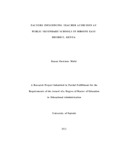| dc.description.abstract | Teacher attrition is a component of teacher turnover and in this study it means the permanent loss of teachers from the teaching service. National statistics indicates that 10,000 teachers are lost annually due to various reasons ranging from resignations, assignment of non-teaching job in other ministries and other quit to join the private sector. Currently more. than 75,000 teachers are needed in secondary schools to replace those lost and to cater for the increasing student enrolments due to the Free Day Secondary Education programme. The main objective in this study was to investigate the factors that influenced teacher attrition at public secondary schools in Mbooni East District. The study sought to determine the extent to which working conditions, teachers' education levels, remuneration packages for teachers, work load and levels of teachers' discipline influenced teachers' exit from the district. The study adopted the Equity Theory of motivation since employees (teacher) retention depends on levels of motivation in their workplace.
The study adopted the Descriptive survey design with a target population was of 252 respondents. Since the population was heterogeneous, the researcher used purposive sampling technique for the DHRO, DEO and the principals. For the teachers who were the other respondents, proportional stratified sampling was used so as to get a representative of the bigger teacher population. Questionnaires, interview guide and document analysis were used to collect data from the respondents. There was demographic and numeric data generated to capture the number of teachers who left teaching in the district. Respondents also gave their own opinions in the open ended questions. Data collected was summarized in tables. Data was presented in frequencies, graphs and pie charts. Descriptive analysis and narratives were used in interpretation of the data generated to make inferences.
After analyzing the data, the study established that 102 teachers had left teaching in the district in the last five years (2007-2012). The study established that teacher attrition was because of individual teacher factor and institutional factors. The study identified inter-district transfers accounting for 36 percent, availability of greener pastures in the private sector 20 percent, interdictions 15 percent, poor remuneration 10 percent, poor working conditions 10 percent and health problems 9 percent as the main push/pull factors that influenced teacher attrition in the district. Due to this, teacher shortage was very high with, mathematics, sciences and languages being the hardly hit. The study established that male teachers were highly affected accounting for the 68% ofthe lost teachers in the district. Teacher attrition was also on an upward trend and it was even more worrying more teachers approximately 100 were undertaking further studies which was established to be a pull factor since those who had gone for further studies accounted for 4 percent of the teachers who left the district either to take up non-teaching duties at the Ministry of Education or teach at tertiary institutions.
Working environment was a major challenge and teacher were working in hardship zone characterized by water shortage, inadequate housing, long distances to and fro work place, majority were residing in the markets near their schools and there were inadequate health facilities. The study concluded that teachers' workload was high with 55 percent teaching more than 27 lessons per week, the recommended Average Teaching Load (ATL) by Teachers Service Commission. This was even made worse since it was compounded by increased enrolment rates occasioned by the Free Day Secondary Education programme started in 2008 and led to increased student numbers. This led to very large classes, congestion, pressure on the existing infrastructure/facilities and increased workload for the teachers.
The schools curbed teacher shortage by employing teachers who were paid by the Board of Governors. Some schools merged classes to make use of the available human resource maximally while other sought the service of their former students who had done well in the previous years and were waiting to join universities. This was to a large extent influencing and compromising the quality of education given to the students in the district. Teachers who were undertaking teaching practice came in handy and helped in reducing teacher shortage though for a short while. Once this 'stand by' teachers left, there were gaps, disruption and continuity was distorted leaving students unhappy and some confused due to being taught by different teachers within a year or so in the affected subject.
In light of the research findings, the study concluded that teachers' level of education, discipline levels of teachers, availability of job opportunities in the private sector that were paying better than teaching service and excess workloads as main push factors: individual and institutional factors. The study recommends that vacant positions be filled immediately to minimize further interruption in the instructional process and reduce instances of compromising the quality of education given to the learners.
There is need to provide incentives that are attractive to teacher with a view of motivating them to remain in the service since teachers always look for jobs whose rates of return are attractive. The study also recommends improvement and continuous review of the scheme of service for teachers to continue motivating them all through so that they can be retained in the service for longer. The study recommends a case study to be carried out on a particular school whose teacher tum-over was worrying with 20 teachers having left the school in the last five years. The study also suggests a research to be carried out on why more male teachers were leaving unlike female teachers since 68 percent of those who left were men. | en_US |

